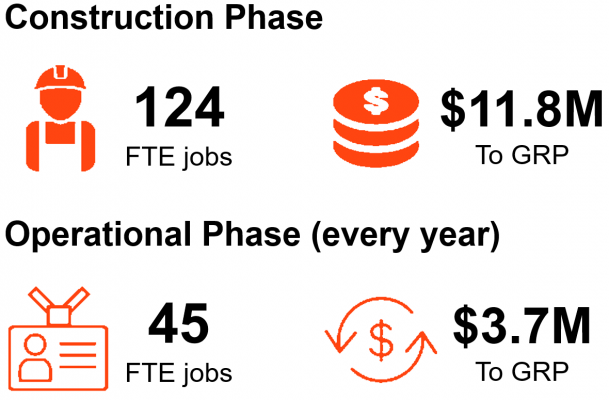Providing safe, effective and accessible health care services is important for the smooth functioning of the community and its economy. However, Australia has a shortage of healthcare professionals and the shortage is expected to get worse as the demand for healthcare services increases. In this blog, John shows how investing in education infrastructure can help a regional area address skill shortages and generate significant economic benefits.
Last year, .id was engaged by Goulburn Valley Health to prepare an economic evaluation of a proposed Rural Clinical Health School to be built in Shepparton, Victoria. The new school is a collaboration between GV Health and La Trobe University and provides nursing, midwifery and allied health undergraduate and post-graduate education. I took on the project as it was quite different to some of the other evaluations we get to work on and also because my wife is a nurse, I am keenly away of some of the challenges getting qualified staff into the system. Regional and rural areas in particular struggle to train and/or retain local staff and rely heavily on costly nursing agencies.
How big is the current nurse shortage in Australia?
To start, just how big is the current shortage of nurses (the primary focus of the new school) in Australia? In June 2022, there were 8,300 online job advertisements for Registered Nurses in Australia, according to the Internet Vacancy Index. This rate is the third highest behind General Clerks (14,800) and Sales Assistants (13,600). But the vacancy of Registered Nurses is significantly harder to fill as the job requires a high skill level and university qualifications.
The shortage of nurses has been growing over the last decade, but the outbreak of COVID-19 intensified the shortage as the demand for nurses increased while the supply decreased following the international border closure. Despite the opening of borders, the shortage remains elevated due to delayed visa processing and global competition for nurses.
Regional Australia has a more severe shortage of nurses and professional health care workers. In 2021, the online jobs advertisement for Medical Practitioners and Nurses in Regional Australia was 0.49 per 1,000 residents. This rate is 36% higher than in total capital cities (0.36 per 1,000 residents).
The shortage of nurses is likely to persist well into the future. According to research by Health Workforce Australia (HWA), Australia will face a shortage of over 100,000 nurses by 2025 and 123,000 nurses by 2030.
What is the current and potential future shortage in Greater Shepparton?
Like other regions in Australia, Greater Shepparton has a shortage of nurses which is likely to get worse in the future. GV Health alone needs another 360 nurses and midwives and 45 allied health staff by 2025 on top of a current shortage of about 175 staff.
To understand the potential future shortage in Greater Shepparton I undertook a demand and supply forecast analysis as part of the project. My analysis showed that Greater Shepparton would face a worker shortage of around 420 Registered Nurses and Midwives by 2036. I then showed that establishing the Clinical Health School would address over 50% of this shortfall.
Do rural clinical schools improve education and local supply outcomes?
To assess the likely nature and scale of benefits from the proposed GV Health Clinical Health School, I also conducted a case study analysis of the La Trobe University Rural Health School’s Clinical Teaching Building in Greater Bendigo.
The establishment of the La Trobe University Rural Health School and the Clinical Teaching Building had a significant impact on the supply of newly trained nurses in Greater Bendigo. In 2016, the number of Registered Nurses aged 20-24 years increased by 38% over the period from 2011 to 2016. This increase was more than three times the total Registered Nurse growth in Greater Bendigo and the growth of Registered Nurses aged 20-24 years in Regional Victoria.
The La Trobe University Rural Health School appears to have influenced education outcomes and the retention of young people. The share of qualified young adults who had studied health still living in Bendigo compared to five years previous went up by 4% between 2011 and 2016. This was much higher than for all qualified young adults. In addition, the share of young adults with a tertiary health degree went up by more than double the rate for young adults with a tertiary degree in the same period.
But, what about the economic benefits of a Clinical School?
Our forecast suggests the proposed Clinical Health school will reduce the shortage of nurses and midwives in Greater Shepparton. But, does it make economic sense? To answer this question, I undertook an Economic Impact Assessment and a Benefit-Cost Analysis.
The construction of the proposed school is expected to have a positive economic impact, supporting 124 FTE jobs and generating $11.8 million to Gross Regional Product (GRP) in Greater Shepparton (based on the 2021 cost estimates). Also, the ongoing operation of the new school is expected to support 45 FTE jobs and add $3.7 million to GRP to Greater Shepparton’s economy every year.

Despite what you might hear from political parties, economic impacts alone are not enough to justify an investment. Any investment will have impacts, but you need to consider if the positive outcomes exceed the cost of investment and by how much. The Benefit Cost Analysis estimated that the benefits to the Greater Shepparton community from the new school significantly outweigh the costs by a ratio of 4. That is, for every $1 million investment, the proposed school is expected to generate an additional $4 million of economic and community benefit. The key benefit of the proposed school was the increase in future earnings of health workers through upskilling and qualifications provided by the Clinical Health School.
So, what was the result of our work?
.id’s comprehensive economic evaluation helped provide independent evidence to support the preparation of a business case for Federal Government funding submissions. Our work clearly showed the proposed Rural Clinical Health School would:
- Help alleviate the shortage of health care workers through an increase in supply and retention;
- Improve the health and wellbeing of local residents in the catchment;
- Provide local youth with a health care career pathway (e.g. from Personal Care Assistance, Enrolled Nurse to Registered Nurse);
- Helps diversify the Greater Shepparton economy by growing the education and health care industry; and
- Deliver a substantial benefit to cost ratio.
A few months ago, I was delighted to hear the new school has been given the go ahead with funding from the Federal Government.
Do you have any projects that can help your community?
Local governments understand they have an important role to play in improving the current and future welfare of the community. As every region is different, it is crucial to understand the risks and opportunities specific to your region and develop strategies, or identify projects, that can respond to them.
The economy.id site for your region is a valuable resource to identify the key trends shaping your community. However, in some cases building a strong narrative is required to link trends with programs and investments in the right areas. Our economic expertise at .id including our specialised health checks and economic evaluations can help do this for you. If you’re involved with economic development at the local government level, learn more about our economic health checks here.
If you are looking to build an economic evidence base to support your business case for State and Federal Government funding submissions, you can use our grant application guide, with step-by-step instructions. Or contact us here for more information about how we can support you.










